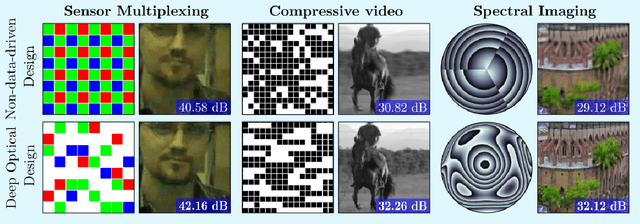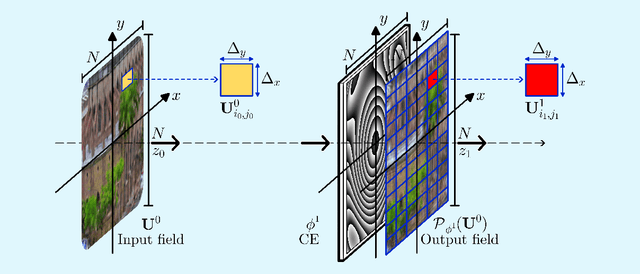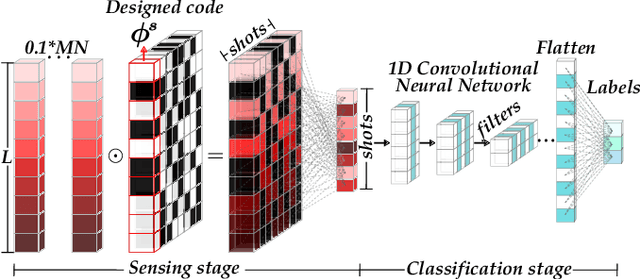Jorge Bacca
Projection-Based Correction for Enhancing Deep Inverse Networks
May 21, 2025Abstract:Deep learning-based models have demonstrated remarkable success in solving illposed inverse problems; however, many fail to strictly adhere to the physical constraints imposed by the measurement process. In this work, we introduce a projection-based correction method to enhance the inference of deep inverse networks by ensuring consistency with the forward model. Specifically, given an initial estimate from a learned reconstruction network, we apply a projection step that constrains the solution to lie within the valid solution space of the inverse problem. We theoretically demonstrate that if the recovery model is a well-trained deep inverse network, the solution can be decomposed into range-space and null-space components, where the projection-based correction reduces to an identity transformation. Extensive simulations and experiments validate the proposed method, demonstrating improved reconstruction accuracy across diverse inverse problems and deep network architectures.
High Dynamic Range Modulo Imaging for Robust Object Detection in Autonomous Driving
Apr 11, 2025Abstract:Object detection precision is crucial for ensuring the safety and efficacy of autonomous driving systems. The quality of acquired images directly influences the ability of autonomous driving systems to correctly recognize and respond to other vehicles, pedestrians, and obstacles in real-time. However, real environments present extreme variations in lighting, causing saturation problems and resulting in the loss of crucial details for detection. Traditionally, High Dynamic Range (HDR) images have been preferred for their ability to capture a broad spectrum of light intensities, but the need for multiple captures to construct HDR images is inefficient for real-time applications in autonomous vehicles. To address these issues, this work introduces the use of modulo sensors for robust object detection. The modulo sensor allows pixels to `reset/wrap' upon reaching saturation level by acquiring an irradiance encoding image which can then be recovered using unwrapping algorithms. The applied reconstruction techniques enable HDR recovery of color intensity and image details, ensuring better visual quality even under extreme lighting conditions at the cost of extra time. Experiments with the YOLOv10 model demonstrate that images processed using modulo images achieve performance comparable to HDR images and significantly surpass saturated images in terms of object detection accuracy. Moreover, the proposed modulo imaging step combined with HDR image reconstruction is shorter than the time required for conventional HDR image acquisition.
Autoregressive High-Order Finite Difference Modulo Imaging: High-Dynamic Range for Computer Vision Applications
Apr 05, 2025Abstract:High dynamic range (HDR) imaging is vital for capturing the full range of light tones in scenes, essential for computer vision tasks such as autonomous driving. Standard commercial imaging systems face limitations in capacity for well depth, and quantization precision, hindering their HDR capabilities. Modulo imaging, based on unlimited sampling (US) theory, addresses these limitations by using a modulo analog-to-digital approach that resets signals upon saturation, enabling estimation of pixel resets through neighboring pixel intensities. Despite the effectiveness of (US) algorithms in one-dimensional signals, their optimization problem for two-dimensional signals remains unclear. This work formulates the US framework as an autoregressive $\ell_2$ phase unwrapping problem, providing computationally efficient solutions in the discrete cosine domain jointly with a stride removal algorithm also based on spatial differences. By leveraging higher-order finite differences for two-dimensional images, our approach enhances HDR image reconstruction from modulo images, demonstrating its efficacy in improving object detection in autonomous driving scenes without retraining.
Generalized Recorrupted-to-Recorrupted: Self-Supervised Learning Beyond Gaussian Noise
Dec 05, 2024Abstract:Recorrupted-to-Recorrupted (R2R) has emerged as a methodology for training deep networks for image restoration in a self-supervised manner from noisy measurement data alone, demonstrating equivalence in expectation to the supervised squared loss in the case of Gaussian noise. However, its effectiveness with non-Gaussian noise remains unexplored. In this paper, we propose Generalized R2R (GR2R), extending the R2R framework to handle a broader class of noise distribution as additive noise like log-Rayleigh and address the natural exponential family including Poisson and Gamma noise distributions, which play a key role in many applications including low-photon imaging and synthetic aperture radar. We show that the GR2R loss is an unbiased estimator of the supervised loss and that the popular Stein's unbiased risk estimator can be seen as a special case. A series of experiments with Gaussian, Poisson, and Gamma noise validate GR2R's performance, showing its effectiveness compared to other self-supervised methods.
Hadamard Row-Wise Generation Algorithm
Sep 04, 2024Abstract:In this paper, we introduce an efficient algorithm for generating specific Hadamard rows, addressing the memory demands of pre-computing the entire matrix. Leveraging Sylvester's recursive construction, our method generates the required $i$-th row on demand, significantly reducing computational resources. The algorithm uses the Kronecker product to construct the desired row from the binary representation of the index, without creating the full matrix. This approach is particularly useful for single-pixel imaging systems that need only one row at a time.
Designed Dithering Sign Activation for Binary Neural Networks
May 03, 2024



Abstract:Binary Neural Networks emerged as a cost-effective and energy-efficient solution for computer vision tasks by binarizing either network weights or activations. However, common binary activations, such as the Sign activation function, abruptly binarize the values with a single threshold, losing fine-grained details in the feature outputs. This work proposes an activation that applies multiple thresholds following dithering principles, shifting the Sign activation function for each pixel according to a spatially periodic threshold kernel. Unlike literature methods, the shifting is defined jointly for a set of adjacent pixels, taking advantage of spatial correlations. Experiments over the classification task demonstrate the effectiveness of the designed dithering Sign activation function as an alternative activation for binary neural networks, without increasing the computational cost. Further, DeSign balances the preservation of details with the efficiency of binary operations.
Computational Spectral Imaging: A Contemporary Overview
Mar 08, 2023Abstract:Spectral imaging collects and processes information along spatial and spectral coordinates quantified in discrete voxels, which can be treated as a 3D spectral data cube. The spectral images (SIs) allow identifying objects, crops, and materials in the scene through their spectral behavior. Since most spectral optical systems can only employ 1D or maximum 2D sensors, it is challenging to directly acquire the 3D information from available commercial sensors. As an alternative, computational spectral imaging (CSI) has emerged as a sensing tool where the 3D data can be obtained using 2D encoded projections. Then, a computational recovery process must be employed to retrieve the SI. CSI enables the development of snapshot optical systems that reduce acquisition time and provide low computational storage costs compared to conventional scanning systems. Recent advances in deep learning (DL) have allowed the design of data-driven CSI to improve the SI reconstruction or, even more, perform high-level tasks such as classification, unmixing, or anomaly detection directly from 2D encoded projections. This work summarises the advances in CSI, starting with SI and its relevance; continuing with the most relevant compressive spectral optical systems. Then, CSI with DL will be introduced, and the recent advances in combining the physical optical design with computational DL algorithms to solve high-level tasks.
Mixture-Net: Low-Rank Deep Image Prior Inspired by Mixture Models for Spectral Image Recovery
Nov 05, 2022Abstract:This paper proposes a non-data-driven deep neural network for spectral image recovery problems such as denoising, single hyperspectral image super-resolution, and compressive spectral imaging reconstruction. Unlike previous methods, the proposed approach, dubbed Mixture-Net, implicitly learns the prior information through the network. Mixture-Net consists of a deep generative model whose layers are inspired by the linear and non-linear low-rank mixture models, where the recovered image is composed of a weighted sum between the linear and non-linear decomposition. Mixture-Net also provides a low-rank decomposition interpreted as the spectral image abundances and endmembers, helpful in achieving remote sensing tasks without running additional routines. The experiments show the MixtureNet effectiveness outperforming state-of-the-art methods in recovery quality with the advantage of architecture interpretability.
Deep Optical Coding Design in Computational Imaging
Jun 27, 2022



Abstract:Computational optical imaging (COI) systems leverage optical coding elements (CE) in their setups to encode a high-dimensional scene in a single or multiple snapshots and decode it by using computational algorithms. The performance of COI systems highly depends on the design of its main components: the CE pattern and the computational method used to perform a given task. Conventional approaches rely on random patterns or analytical designs to set the distribution of the CE. However, the available data and algorithm capabilities of deep neural networks (DNNs) have opened a new horizon in CE data-driven designs that jointly consider the optical encoder and computational decoder. Specifically, by modeling the COI measurements through a fully differentiable image formation model that considers the physics-based propagation of light and its interaction with the CEs, the parameters that define the CE and the computational decoder can be optimized in an end-to-end (E2E) manner. Moreover, by optimizing just CEs in the same framework, inference tasks can be performed from pure optics. This work surveys the recent advances on CE data-driven design and provides guidelines on how to parametrize different optical elements to include them in the E2E framework. Since the E2E framework can handle different inference applications by changing the loss function and the DNN, we present low-level tasks such as spectral imaging reconstruction or high-level tasks such as pose estimation with privacy preserving enhanced by using optimal task-based optical architectures. Finally, we illustrate classification and 3D object recognition applications performed at the speed of the light using all-optics DNN.
Deep Coding Patterns Design for Compressive Near-Infrared Spectral Classification
May 27, 2022



Abstract:Compressive spectral imaging (CSI) has emerged as an attractive compression and sensing technique, primarily to sense spectral regions where traditional systems result in highly costly such as in the near-infrared spectrum. Recently, it has been shown that spectral classification can be performed directly in the compressive domain, considering the amount of spectral information embedded in the measurements, skipping the reconstruction step. Consequently, the classification quality directly depends on the set of coding patterns employed in the sensing step. Therefore, this work proposes an end-to-end approach to jointly design the coding patterns used in CSI and the network parameters to perform spectral classification directly from the embedded near-infrared compressive measurements. Extensive simulation on the three-dimensional coded aperture snapshot spectral imaging (3D-CASSI) system validates that the proposed design outperforms traditional and random design in up to 10% of classification accuracy.
* 5 pages, 5 figures
 Add to Chrome
Add to Chrome Add to Firefox
Add to Firefox Add to Edge
Add to Edge